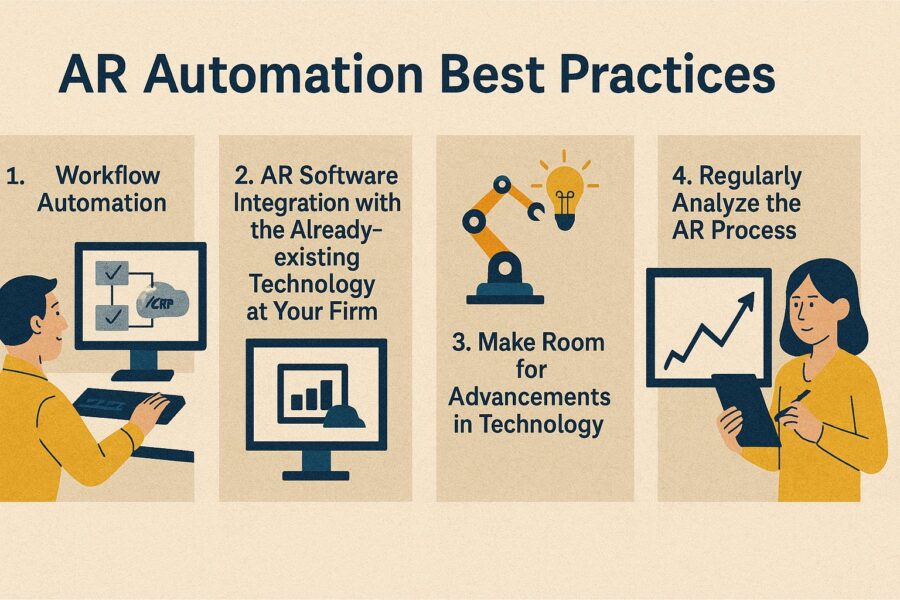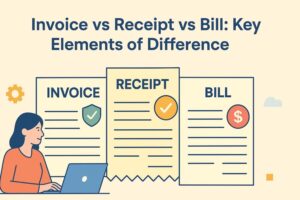Accounts Receivable Invoice Automation: Purpose & How it Benefits Businesses in 2025
- 4 Nov 25
- 14 mins

Accounts Receivable Invoice Automation: Purpose & How it Benefits Businesses in 2025
- The Meaning & Purpose of Accounts Receivable Automation
- Why is AR Automation a Necessity for Businesses in 2025?
- Accounts Receivable Automation Benefits
- How Does AR Automation Eliminate the Manual AR Aspects?
- AR Automation: How it Works
- AR Automation Best Practices
- How To Automate Accounts Receivable?
- Conclusion
Key Takeaways
- AR automation replaces manual, error-prone data entry and invoicing with software-driven precision, ensuring accuracy, faster payments, and fewer customer disputes.
- Businesses using AR automation have seen up to a 40% acceleration in payments and 92% improvement in cash flow visibility, freeing finance teams for more strategic tasks.
- Through digital collaboration options like self-service portals and multiple payment modes, customers enjoy transparency, flexibility, and faster resolution cycles.
- Real-time dashboards and analytics empower AR leaders with data visibility across invoices, collections, and credit risk, helping refine cash flow and credit management strategies.
- AR automation ensures financial compliance, data security, and effortless scalability, enabling businesses to manage growth efficiently and stay competitive in 2025 and beyond.
Are manual accounts receivable processes draining the productivity of your dedicated teams and negatively impacting cash flow for your company? The feeling is mutual between several businesses in India! Manual AR processes have been known to lead to errors, delayed payments, and compromised cash flow visibility.
What’s the solution, you may be asking? It’s the revolutionary accounts receivable automation tool! 92% of companies have experienced a boost in cash flow post-implementation of the AR automation software. The same research further affirms that AR automation has accelerated payments by a whopping40%.
Let’s further discuss how accounts receivable invoice automation can empower your team to improve overall financial performance.
The Meaning & Purpose of Accounts Receivable Automation

If only you could automate invoice generation, streamline the payment tracking process, and simplify the management of cash flow through software installation, several errors could be avoided! Well, now you can achieve it with the accounts receivable invoice automation system.
Accounts receivable automation is essentially the process of automating AR operations. It leverages software solutions driven by the latest technology. The software helps eliminate or at least minimise manual effort, which is otherwise required in the completion of tasks like:
- Generation and address of invoices to customers,
- Tracking of the payments,
- Following up on any late payments.
AR automation manages and tracks the pending invoices that customers have yet to address. It not only reduces the workload for your organisation but also boosts the payment collection system, offering a range of convenient modes of payment. Plus, there is minimal scope for errors once AR automation is favoured over manual processes.
Why is AR Automation a Necessity for Businesses in 2025?
The management of accounts receivable involved tedious and time-consuming tasks like:
- Manual data entry
- Chasing late payments
- Reconciling invoices, etc.
As a business grows, the complexity levels inevitably increase. Thus, this is where AR automation acts as a major tool to optimise cash flow, erase the possibility of errors, and free up time for other financial activities, which may yield higher-value returns for the organisation.
Here are some specific reasons as to why businesses need AR automation in 2025:
1. Accounts receivable automation boosts the accuracy of the task outcomes by eliminating the scope of human errors in the field of data entry.
2. AR automation minimises the time as well as effort needed to complete otherwise routine tasks for accountants.
3. It helps banks rely on the real-time visibility of invoices and receivables statuses.
4. AR automation ensures customer satisfaction by accounting for consistency and clear communication.
5. It boosts the efficiency of operations between the companies' teams dedicated to accounting.
Accounts Receivable Automation Benefits
With Accounts receivable automation, businesses are able to transform their financial management with clean precision, reducing reporting errors by up to 90%. With that in mind, let’s look at some benefits of Accounts receivable automation:
1. Cost Minimisation in Accounts Receivable
Tap into the transformative power of accounts receivable automation and slash accumulating costs by over 70% on invoicing expenses. Now leave the paper invoices behind and switch to electronic ones for a timely delivery guarantee. This shall boost customer satisfaction as a result.
In addition, automate cash applications and bid farewell to 100% of lockbox data capture fees. This shall significantly reduce the operational costs. A more efficient AR process, saving time and money, shall result.
2. Automated Payment Collections with Reduced Days Sales Outstanding (DSO)
Level up your accounts receivable management system by harnessing the power of AI-driven insights. With capabilities like:
- Payment date prediction
- With dynamic customer segmentation, etc., you can pinpoint high-priority customers. Thus, tailor your payment collection strategies to maximise the output.
Further, empower your customers to pay on time by:
- Integrating self-service portals
- Incorporating more payment options
Minimise the Days Sales Outstanding (DSO) in this way and inject new momentum into the cash flow.
3. Credit Risk Mitigation Prompting the Reduction of Bad Debts
Manage credit risk effectively by leveraging the AI-based automation tools. Use them to:
- Fast-track the reviews,
- Keep up with negative payment trends,
- Make sense of any external bankruptcy alerts,
- Track credit utilisation thresholds
Such insights will positively put the credit teams in your business in control and deem them capable of improving bad debt by managing the orders which are coming up.
4. Access to Important Accounts Receivable Metrics
Certain advanced AR automation tools offer:
- An interactive user interface
- Real-time view of data against the order-to-cash process
Senior AR leaders are able to refer to this comprehensive visibility feature and, as a result, analyse process health. They can also access the analyst productivity metrics. This further allows for:
- Strategy-based decision-making
- Course corrections, etc.
5. Boosted Productivity
The automation of otherwise manually tackled tasks boosts productivity, directing it towards more important aspects. AR automation frees the AR analysts from time-consuming processes, including:
- Claims aggregation
- Cash application
- Credit report aggregation & scoring manually
Thus, the teams can focus more on strategic work, ensuring the business’s overall growth.
6. 100% Customer Satisfaction
You can ensure 100% customer satisfaction by extending options for collaboration digitally, like via:
- Self-service portals
- Online payment modes
- Integration into the accounts payable portals
Customers shall feel more confident with the independence factored in through:
- The management of their invoices,
- Boosting cash flow,
- Establishing stable relationships between the customer and vendor.
Such simplification of online payment processes eliminates the requirement for any follow-up collection calls. Payments are thus made secure and hassle-free, increasing security levels through PCI compliance.
7. Enhances Security & Compliance
Various AR automation tools assist businesses with financial regulation compliance. They also establish the security of the data.
Such tools have regulatory frameworks, which assure that payments, invoicing, and collections all fall within the legal moulds and meet standards set by the industry. It allows businesses to avoid regulatory penalties while retaining a trust-bound relationship with customers.
8. No Blockages in the AR Process
Accounts receivable automation essentially streamlines the whole order-to-cash process. It establishes a seamless and integrated experience departments-wide. Connecting all the teams and facilitating the real-time exchange of data, AR automation allows for efficient collaboration and well-charted-out decision-making.
For example, the teams responsible for collections shall receive instant notifications regarding any issues. Such issues may include:
- Blocked orders, or
- Invalid deductions.
They can then prioritise their actions effectively and resolve the outstanding balances as soon as possible.
How Does AR Automation Eliminate the Manual AR Aspects?

The table below highlights the challenges which the accounting teams face when it comes to manual accounts receivable processes. Also, find out how automating AR gets rid of those issues.
In case of Manual Accounts Receivable
- Inefficiency & Human Error: AR collections are very much prone to errors due to mistakes made during data entry. This leads to late payments and disputes with customers.
- Limitations posed in terms of visibility & analysis of data: Due to not enough real-time insight into the various payment statuses/trends, it becomes difficult to pinpoint problems promptly. One can potentially misses out on otherwise valuable insight.
- Delays in cash flow & Issues with scalability: Late payments and slow collections have an effect on cash flow. This acts as an obstacle in one's plan to invest further in opportunities for growth/meet set obligations.
In case of Accounts Receivable Automation
- Efficient & No Scope for Error: Human error can be completely eliminated by automating data entry as well as invoice generation. This shall lead to reduced payment delays and disputes with consumers.
- Boosted visibility or insights: It extends real-time updates on the various payment statuses/trends. This lets businesses quickly identify the loopholes and initiate measures effectively.
- Boosted cash flow & scalability: It speeds up the collections process with the help of on-time invoicing/automated reminders. This helps improve cash flow as well as liquidity.
💡Keep track of your transactions and pay your business-related bills with the PICE App.
AR Automation: How it Works
Automated accounts receivable makes use of the latest technology to manage tasks like keeping track of payments, generating invoices, and keeping tabs on collections. These processes are simplified by revolutionary technology. It accomplishes the following:
- Sends forth payment reminders,
- Updates relevant payment statuses instantly,
- Ensures that the accounts are reconciled.
Here is a closer look at how AR automation works:
Step 1: Invoice generation/delivery streamlining process
Businesses are now able to automate the generation and delivery processes of invoices with the assistance of AR automation. This software draws information from the organisation’s accounting/ERP system to automatically generate the invoices. These invoices are delivered electronically to the clients. Here are the channels via which the invoices are commonly delivered:
- Electronic data interchange (EDI)
- Customer portals
These channels facilitate a much faster delivery process, minimising the requirement for manual processes.
Step 2: Availing payment modes for seamless transactions
Simplifying the process of initiating payments on the customers’ ends helps greatly. AR automation solutions offer up different gateways of payment and electronic payment options, including:
- ACH transfers,
- Credit card payments,
- Electronic funds transfers (EFTs).
Step 3: Payment reminders automation
Sending reminders for payments to customers manually is a time-consuming task. It demands customer prioritisation and the tracking of due dates across the board. However, AR automation solutions make this process much easier by sending off automated reminders/notifications for any overdue/upcoming payments. Such reminders can be personalised and sent through:
- SMS
- Customer portals
It boosts communication and, at the same time, minimises the scope of delayed payments.
Step 4: Reporting Simplified
Accounts receivable automation extends a robust range of features, adhering to reporting/analytics. It generates the reports on the following:
- AR aging
- Forecasts of cash flow
- Collection performance
- Customer payment trends
Such insights allow the teams dedicated to finance within an organisation to arrive at informed decisions. They also get to conveniently optimise strategies related to the management of receivables.
Consider the following example:
Say, a customer buys certain goods on credit from you. You are required to send them an invoice addressing the goods purchased, related costs, etc. AR automation works in this way:
- You have to generate the correct invoices, formatted in a way that meets the requirements of the customer’s accounts payable.
- Once this invoice is generated, it is sent to the customer via email automatically. Delays are eliminated this way, and prompt delivery is ensured.
- As the customer receives the invoice, the AR system keeps track of when it was received, viewed as well as paid off.
- If the payment has not been made and the due date is nearing, an automated reminder is sent. It nudges the customer to settle the balance immediately. The reminder's content may be tailored to the customer's payment.
- In case the due date is missed, the system shall continue to follow up. It automatically adjusts the tone as well as the frequency of reminders. This will be on the basis of the customer's response.
AR Automation Best Practices

AR processes are capable of greatly improving process efficiency through the simultaneous reduction of manual errors. The following are the best practices which you must keep in mind for AR automation implementation:
1. Workflow Automation
Boost the efficiency of your business operations with the right automation software by:
- Streamlining the workflows and approval processes; therefore, minimise delays
- Automating tedious tasks like client follow-ups, invoice retrieval, credit approval processes, etc.
Thus, eliminate manual effort and increase productivity - create a win-win situation overall!
2. AR software Integration with the Already-existing Technology at Your Firm
Make sure that your AR automation solution is the type that will easily be integrated with the existing systems at your company, like:
- ERP,
- CRM, etc.
This is essential as it will:
- Enhance the data accuracy,
- Improves visibility department-wide,
- Supports efficient decision-making.
3. Make Room for Advancements in Technology
Make sure to prioritise upgrading your AR processes. Achieve this goal by leveraging any technological advancements available at hand, including:
- Automated e-billing
- Automated deductions
- Follow-up emails, etc.
Implementation of such innovations shall help in streamlining the billing procedures and enhance the impact and efficiency.
4. Regularly Analyse the AR Process
The complexity shall grow as your business grows. Managing accounts receivable shall become far more complex eventually. Thus, make sure that your business conducts regular audits as well as performance reviews of the AR processes to stay on track. It will prompt the following:
- Identification of areas for improvement
- Streamlining of workflows
- Adjustment of strategies on the basis of data insights/feedback
How To Automate Accounts Receivable?
Step 1: Identify the goal that needs to be achieved through automation
Start off by setting clean-cut goals for your AR automation. Determine the scope beforehand:
- Automate particular processes (for example, invoicing, collections, cash application)
- Automate the end-to-end accounts receivable
- Target a specific department/the entirety of the AR function
Such a level of clarity shall guide your automation strategy and bring forth the desired impact.
Step 2: Chalk out a comprehensive As-Is & to-Be automation state
Next, you must define your AR process clearly:
- Current state: Mention the existing workflows and applicable pain points
- Future state: Highlight the desired outcomes you wish to see after automation
Communicate with clarity to your vendors, so they are better equipped to:
- Get an idea about your requirements
- Develop a transformation plan tailored to your needs
It shall ensure a much more seamless implementation process, fetching better results.
Step 3: Evaluate & select vendors for automation
As per your business’s unique requirements, review the various receivables solutions. You’ll get an idea about whether a vendor is capable of delivering the expected outcomes or not.
Make sure to review the vendor's results from the past, as such knowledge becomes a crucial instrument, capable of aiding your vendor-selection session.Therefore, settle on the appropriate accounts receivable software which shall fit your specific business requirements. This way, ensure the expected ROI and more.
Step 4: Keep track of the transformation progress constantly
Define various checkpoints in your AR automation timeline to keep track of the transformation progress. Thus, you shall be able to make sense of whether or not the transformation is going the way you expect it to.
If a conflict happens to arise obstructing the expected goal, you can inform your AR automation vendor immediately. Get to discuss all course corrections possible.
Conclusion
By implementing accounts receivable automation, businesses will be able to transform their financial operations. With a reduction in manual errors, streamlining of invoices and various payment processes, businesses shall wield better control over their finances.
This will, in turn, lead to improved cash flow and faster payments. With efficient AR processes, especially accounts receivable invoice automation, businesses can build dependable customer relationships, minimise administrative burdens, and focus more on driving innovation, growth and success.



















